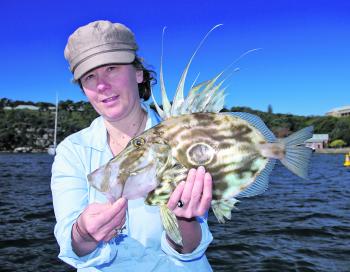Water temps have finally dropped down to their normal winter low of 16 degrees. This comes after an extended summer season where water temps held up around the 20 degrees mark well into June.
Kingfish and other surface fish have cleared out but have been replaced with a strong influx of traditional winter species, particularly john dory and trevally. We are also experiencing a spectacular run of winter flathead.
There has been some good lure fishing for school mulloway above Gladesville Bridge but those chasing them have found themselves plagued by flathead. Anglers have been nailing up to 30 in a session with fish up to 2kg being caught. The drop-offs on the flats in the lower reaches have also been producing, as have the sand patches amongst the moorings in North Harbour. Small plastics in the 3-4” range will produce the most fish. If you want to increase your chances of a mulloway then go to a 6” lure. This will also produce bigger flatties, albeit in smaller numbers.
Remember the critical thing with fishing lures for flathead and mulloway, keep the lure in contact with the bottom. Make sure you use a heavy enough lead head so that you can clearly see the touch down through your line as the lure hits the bottom. This is aided by using hi-vis braid lines. Detecting the touch down can get more difficult in either strong wind or current. The best remedy is to make sure you cast down current in a manner that ensures that the current is not applying any side pressure on your line. On windy days, keep the wind on your back. You will need to re position regularly in order to cover plenty of ground.
John dory are one of the classic winter immigrants. They live on the offshore reefs in summer and move into the bays and harbours when the water gets cold. They are mostly found around the lower reaches yet can be caught up stream when the water quality is good. They like deep, still, clear water and congregate around structure that holds plenty of baitfish. Boat moorings, bridge pylons, jetties, reefs and drop-offs are all prime spots.
It’s very rare to catch John dory on anything other than live baits. Best livebaits include yellowtail (with the tail trimmed) or any small reef fish like sweep or mado. John dory have an enormous mouth and will have no trouble swallowing a 15cm sweep.
They are not a good fighting fish but due to the possibility of picking up larger predatory fish on your live bait I would suggest using no less than 6kg line. The rig consists of a size 4 bean sinker on the main line, terminated by a swivel. A five foot nylon trace of about 10kg breaking strain is then tied to the swivel and finished off with a 4\0-6\0 Mustad Big Red hook.
The bait is then suspended directly under the boat or jetty about 2m off the bottom. The best time to catch John dory is on the turn of the high tide, early morning or late afternoon.
Trevally must have a wide temperature tolerance because they are very common in summer and winter. They are a very good fighting fish and very underrated as a table fish. Just like John dory, trevally like clear, deep water but will range well upstream in dry weather. Being an active pelagic fish they are happy to hold in the current, which makes them more common around the main channels and headlands. At times they will school and feed on the surface. When this happens they will readily accept small lures and provide very good sport.
The most common method of fishing for trevally is with bait on very lightly weighted rigs. They mostly feed from mid water to the bottom, so you must choose a sinker that will take your bait into that zone. The best rig is a mainline of 4kg with a nylon trace about the same. The sinker runs on the mainline and stops at the swivel that separates the mainline from the trace. Hook size should be somewhere between no.4 and no.1. A bait holder pattern is most suited to the type of baits used. Best baits are small cuts of baitfish like pilchard, gar, bonito or slimy mackerel. A good berley trail of pellets or mashed fish is very beneficial. North Harbour, particularly around Flagstaff, and the channels around Sow and Pigs Reef and the Wedding Cakes are all producing plenty of trevally.
Reads: 1567
Trevally are abundant around Sydney and a fun on light tackle.

Flathead love a well presented soft plastics hoped across the bottom.

John Dory move in close when the water cools and are suckers for a livebait.




